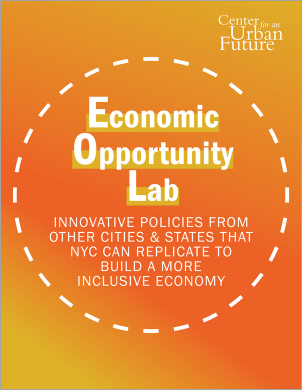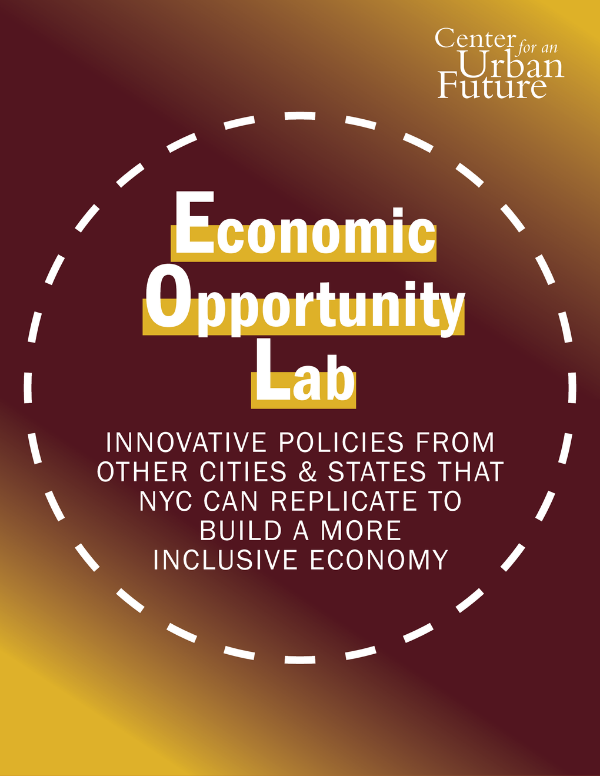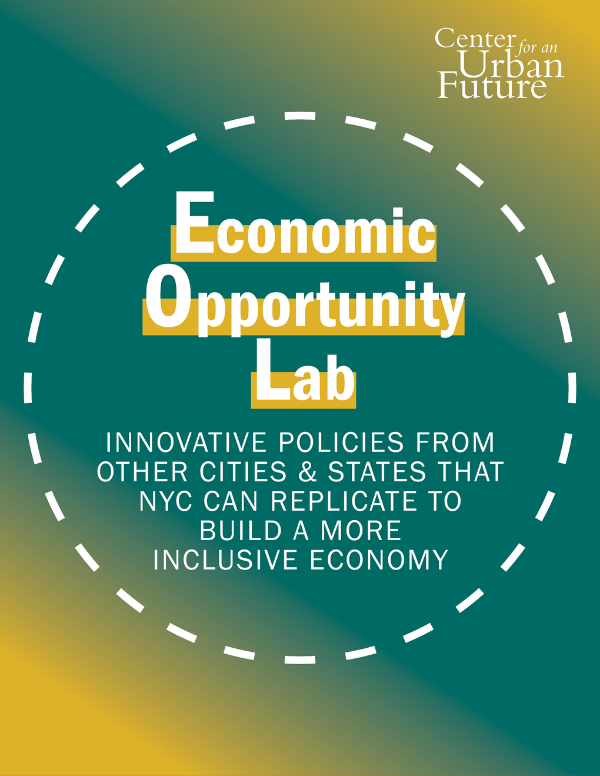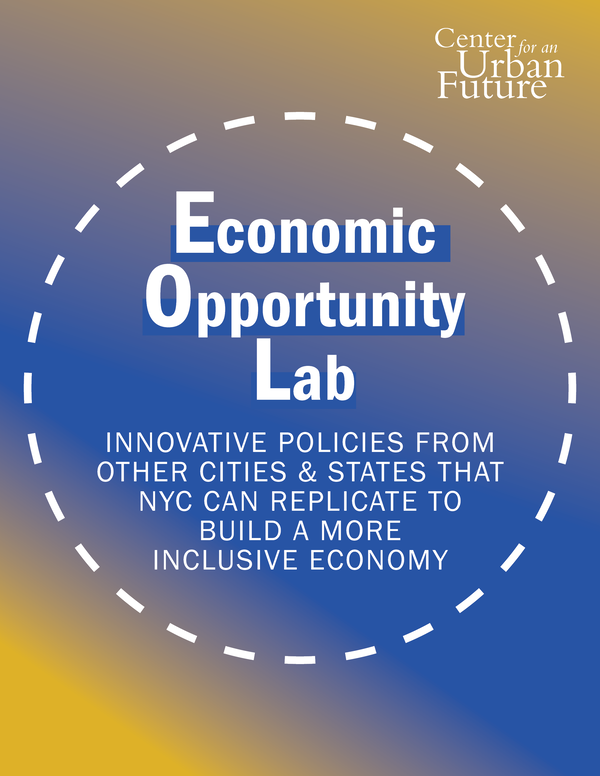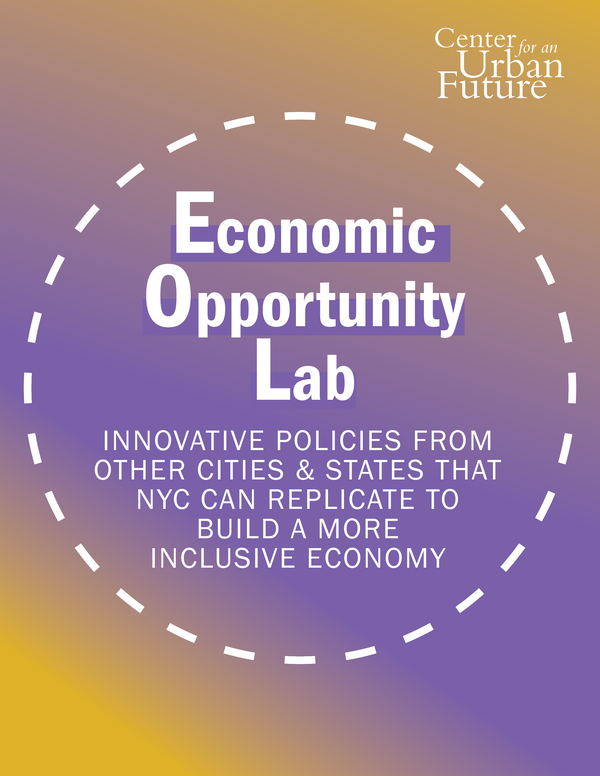
Over the past four years, more than 20 cities and states across the country have launched guaranteed income pilot programs, from Compton, California, to Columbia, South Carolina. This year, several more cities plan to follow suit, with the aim of alleviating poverty by putting cash into the hands of low-income individuals and families, with no strings attached. One promising new intervention in Santa Clara County, California, is providing a basic income to members of a particularly vulnerable population: young adults aging out of the foster care system.
For New York City leaders following the rise of basic income pilots nationwide, the early success of California’s experiment should provide inspiration for a similar initiative in New York.
Young people aging out of New York City’s foster care system face daunting odds. Barely 1 in 5 has finished high school or earned a high school equivalency degree and only 1 in 3 has a verified source of income at the time of discharge.1 Outcomes data for this population is extremely limited, but past studies have found that as many as 1 in 5 enter a homeless shelter within three years of aging out of the system. (In 2020, about 5 percent of young adults who exited the system entered a shelter within one year.) A 2015 report found that nearly 1 in 6 had spend time in jail within six years.2 Almost one-third (32 percent) of homeless youth in New York have been in the foster care system.3 The share is likely even higher for Black homeless youth, with as many as 50 percent having spent time in foster care.4
These troubling outcomes suggest that much more support is needed for youth as they are exiting the foster care system. There’s a strong case that city and state government officials in New York should be providing that help. After all, foster youth are wards of the state. Without familial or financial support, it’s not surprising that many emerging from foster care struggle to successfully establish independent lives.
Adopting a government-funded guaranteed income for youth transitioning out of foster care could help them navigate these crucial first months of independence and give them better odds of succeeding on their own.
California offers a promising model for New York City policymakers to follow. Launched in July 2020 in Santa Clara County, this basic income pilot program—the first in the nation to specifically benefit those exiting the foster care system—provides $1,000 per month in unrestricted income to 72 young adults. Encouraged by promising results from the first year of the program, the county’s board of supervisors allocated additional funding to extend the program for another six months. Participants have reported a number of positive outcomes, including increasing credit scores and savings, earning a college credential, maintaining stable housing, and reporting feeling empowered to reach life goals.
In New York, only a small percentage of foster youth get anything resembling this type of assistance. Indeed, each year, more than 500 young people in New York City leave foster care, yet only 3 percent of them report receiving cash assistance within 6 months of doing so.5 One consequence, say experts who work with transition-aged young adults, is that the pressure builds to seek employment rather than education or career training, and housing instability, food insecurity, and the risk of justice involvement are all heightened.
“Young people transitioning out of foster care have a variety of needs that average young people that age don’t have,” says Mark Courtney, a professor of social work at the University of Chicago and an expert in the evaluation of foster care policies. “Middle-class parents invest money in their young adult children and don’t expect them to have to meet their own needs; they want them to acquire that human capital. Why wouldn’t we want that for young people aging out of foster care?”
The pandemic has further exacerbated the need to shore up support for young adults in transition. Fully 27 percent of all New Yorkers between the ages of 18 and 24 were out of school or out of work in 2020—the highest share in more than a decade.6 For former foster youth exiting the system into a pandemic, the challenges are especially daunting. Yet despite the expansion of important support programs like New York’s Fair Futures initiative, which provides intensive life coaching services to young people in foster care, a lack of financial support for transition-aged youth remains a persistent challenge.
“It’s become harder for folks to access social services, and removing some of those administrative burdens and hurdles would be really important,” says Madeline Neighly of the Economic Security Project, a nonprofit that is consulting on basic income programs across the country. “Guaranteed income is a way of shifting power in our society and our economy, by committing to cash and trust.”
The Policy
The first guaranteed income program in California directed at former foster youth is under way in Santa Clara County. Launched in July 2020 with a $500,000 investment from the county’s board of supervisors, the program provides 72 former foster youth ages 21 to 24 with $1,000 each month in unrestricted income. Promising results from the program’s first year prompted Santa Clara County to expand the program for an additional six months, with additional funding for financial counseling services and surveys to help establish clear outcomes. Inspired by the Santa Clara pilot program, California’s state legislature passed a bill in July 2021 to expand the model statewide, providing a guaranteed income to approximately 2,500 former foster youth each year.
Like New York, California is responsible for thousands of young people in foster care and has a significant problem with poor outcomes that follow an exit from the system. A study commissioned by California’s State Senate found that 14 percent of all people incarcerated in California’s prisons had been in foster care.7 Fully one in four former foster youth in California have been homeless within two years of leaving the system.8 The Santa Clara pilot was envisioned to help bridge the gap from foster care to financial independence, while reducing the risk of these troubling outcomes.
“Meeting those basic needs is important,” says Mark Courtney, who has evaluated the effectiveness of California’s foster care programs. “If you give people resources so that they have a place to live and they can afford to eat, that allows the young people who would pursue postsecondary education or continuing education to do that.”
Sparky Harlan, CEO of the Bill Wilson Center, which serves homeless and foster youth in Santa Clara County, says that the program is already starting to demonstrate that a basic income, combined with other supports, can help former foster youth make major strides toward financial self-sufficiency, including by pursuing college or career training without going hungry or losing stable housing. Given the sharp financial shock caused by the pandemic, she explains, a basic income proved even more essential for avoiding the worst outcomes among this high-risk population.
“They were able to keep their food and pay rent,” says Harlan. “The program also really helped with those who were in school, with that extra support needed to keep them enrolled—and this also was being done during COVID, so for some of our population who had been working too and lost jobs, it helped there.”
Veronica Vieyra, 25, credits the basic income program with helping her stay in college and complete a bachelor’s degree in public health at San Jose State University. She was just a year away from graduation when the pandemic hit, closing the college’s dorms and sending students home. Except Vieyra, formerly in foster care, did not have a home to return to.
“I was boxing up my stuff and thinking I might be living on the streets,” she says. Fortunately, Vieyra heard about the basic income pilot program and was selected as one of the initial participants.
"It really was like a superhero coming in to save the day," Vieyra says. "A lot of us when we exit foster care have no idea what to do next. We don't have savings and we are struggling. This program came in as a second chance to save money and plan for the future."
This move toward guaranteed income has spread across California. In addition to the statewide expansion of the foster care basic income program, Los Angeles County has also moved forward on an initiative to fund a guaranteed income project with county dollars. In July 2021, the county passed a motion to create a pilot program providing a monthly income to young adults who are participating in an employment training program called TAYportunity (for transition-age youth, or TAY). This program aims to help individuals between 18 and 24 years old, many of whom have recently aged out of foster care or probation systems. According to the supervisors’ motion, 31 percent of young adults receiving cash assistance are homeless, and the average amount totals just $221. The program would provide these young adults with an income of $1,000 per month, as well as $204 in CalFresh food benefits.9
The Challenge
Despite growing awareness of the needs of young people in foster care among New York City leaders, post-transition outcomes continue to be a cause for alarm. While the city’s efforts to extend some foster care supports to age 21—and now, as proposed by Mayor Adams, to age 26—are undoubtably a step forward, more is needed to help break the cycles of poverty, homelessness, and justice involvement that disproportionately impact former foster youth.
1. Removing barriers to cash assistance.
“Part of the government’s obligation is to resource young people so we have a successful society,” says Larry Cohen, executive director of Point Source Youth, a New York-based nonprofit that is experimenting with a cash transfer program to help address youth homelessness. “Direct cash transfers trust young people, and without trusting them, we’re never going to make any progress. My hope is that in five years, every person who has worked in New York City’s shelter system, or foster care system, will say, ‘Why didn’t we just give people money in the first place?’”
Experts suggest that a basic income for former foster youth in New York could help change this, in part by helping to circumvent the barriers to accessing cash assistance in the first place. Even though the vast majority of transition-aged foster youth are eligible for means-tested forms of assistance, just 3 percent report receiving any form of cash assistance in the first six months after exiting the system.10
“For young people exiting foster care, there is no question that cash is an evidence-based intervention,” says Amy Lemley, executive director of John Burton Advocates for Youth, a nonprofit that advocates for youth who have been in foster care or homeless. “So many programs for young people in foster care have these participation conditions. They have the often unintended effect of narrowing access. When you are struggling with housing security or food security, even the most seemingly benign requirements can limit access.”
Although some policymakers have expressed concern that recipients of cash assistance will make unwise decisions with their money, a growing body of research suggests that this is not the case. Previous guaranteed income projects, such as the highly successful Stockton Economic Empowerment Demonstration (SEED) in San Joaquin County, California, show that participants used the cash payments for necessities, job searching, and savings—not on alcohol (which amounted to less than 1 percent of spending) or drugs. In the SEED effort, “125 people were given a guaranteed income of $500 each month for 24 months. A hand-up rather than a hand-out, SEED sought to empower its recipients financially and prove to its supporters and skeptics alike that poverty results from a lack of cash, not character.”11 A year after launch, for example, 40 percent of SEED participants had a full-time job, versus 28 percent at the start.
2. Launching and scaling pilot programs with the backing of city government.
In New York, which has so far been largely sidelined amid the boom in basic income pilots, a handful of nonprofits are attempting to close these gaps with cash—a strategy which could scale up with strong support from local government.
For instance, New Yorkers for Children reported an increase in requests for emergency grants as a result of the pandemic and awarded 68 percent of its 2020 emergency grants to youth who had aged out of foster care and were not in school.12 Another New York nonprofit, Point Source Youth, is developing a pilot program to provide housing insecure youth with direct cash transfers, but only has the funding to serve 30 to 40 young adults.
Mayor Adams has already indicated his support for expanding the Fair Futures program, which is providing crucial life coaching support to foster youth in the city—and could expand to reach former foster youth through age 26. By incorporating a significant basic income component, Mayor Adams could follow California's lead and help make the Fair Futures program even more powerful. A successful program in New York City could also help convince state leaders to create a permanent tax credit for foster youth, as California is now considering.
“Philanthropy has a very big role in pushing the envelope and showing what is possible,” says Neighly of the Economic Security Project. “And then public dollars have to come in to make it long lasting.”
Conclusion
The growth of basic income pilot programs nationwide—and a raft of promising early outcomes—presents New York City leaders with an important policy tool to help strengthen support systems for some of the most vulnerable New Yorkers. Mayor Adams has already expressed interest in exploring cash assistance with his NYC AID proposal, and in bolstering support for foster youth as they enter adulthood via the Fair Futures initiative. Now is the time to combine these approaches by creating a cash assistance program for transition-aged foster youth.
Although the city has made strides to improve foster care in recent years, a lack of support for youth after they exit care contributes to unacceptably high rates of homelessness, incarceration, and economic instability, all of which disproportionately affects young people of color. A basic income program for New Yorkers aging out of foster care, developed in collaboration with directly impacted young adults, could help catalyze better outcomes in the short term and lead to more equitable economic opportunities in the future.
Endnotes
1 Center for an Urban Future analysis of data from NYC Administration for Children’s Services, “ACS Report on Youth in Foster Care, 2020,” https://www1.nyc.gov/assets/acs/pdf/data-analysis/2020/ReportOnYouthInFC2020.pdf.
2 Data on shelter and jail entry from "Young Adult Outcomes of Foster Care, Justice, and Dually Involved Youth in New York City," NYC Center for Innovation through Data Intelligence (CIDI), June 2015, https://www1.nyc.gov/assets/cidi/downloads/pdfs/foster_care_justice_and_dually_involved_exec_summary.pdf.
3 Research, Education, and Advocacy Co-Lab for Youth Stability and Thriving (REALYST), “Homeless youth risk and resilience survey,” 2018. Retrieved from realyst.org.
4 Estimate from Larry Cohen, executive director of Point Source Youth.
5 NYC Administration for Children’s Services, “ACS Report on Youth in Foster Care, 2020,” https://www1.nyc.gov/assets/acs/pdf/data-analysis/2020/ReportOnYouthInFC2020.pdf.
6 JobsFirstNYC, “Equitable Recovery for Young Adults: An Agenda for Young Adult Workforce Development in New York City,” October 2021, https://jobsfirstnyc.org/wp-content/uploads/2021/10/JF_YoungAdultAgenda_final.pdf.
7 California Senate Office of Research, “State Survey of California Prisoners,” December 2011, https://sor.senate.ca.gov/sites/sor.senate.ca.gov/files/State%20Survey%20of%20California%20Prisoners.pdf
8 Mark E. Courtney, et. al., Findings from the California Youth Transitions to Adulthood Study, University of Chicago, 2020, https://www.chapinhall.org/wp-content/uploads/CY_YT_RE1020.pdf
9 “General Relief [GR] TAYportunity Guaranteed Income Demonstration Project,” July 27, 2021, http://file.lacounty.gov/SDSInter/bos/supdocs/160431.pdf.
10 NYC Administration for Children’s Services, “ACS Report on Youth in Foster Care, 2020,” https://www1.nyc.gov/assets/acs/pdf/data-analysis/2020/ReportOnYouthInFC2020.pdf.
11 Stacia West, Amy Castro Baker, Sukhi Samra, and Erin Coltrera, “Preliminary Analysis: SEED’s First Year,” https://www.stocktondemonstration.org/#summary-of-key-findings.
12 New Yorkers for Children, “2020 Annual Report,” https://www.newyorkersforchildren.org/wp-content/uploads/2021/11/NYFC-2020-Annual-Report-FINAL.pdf.
